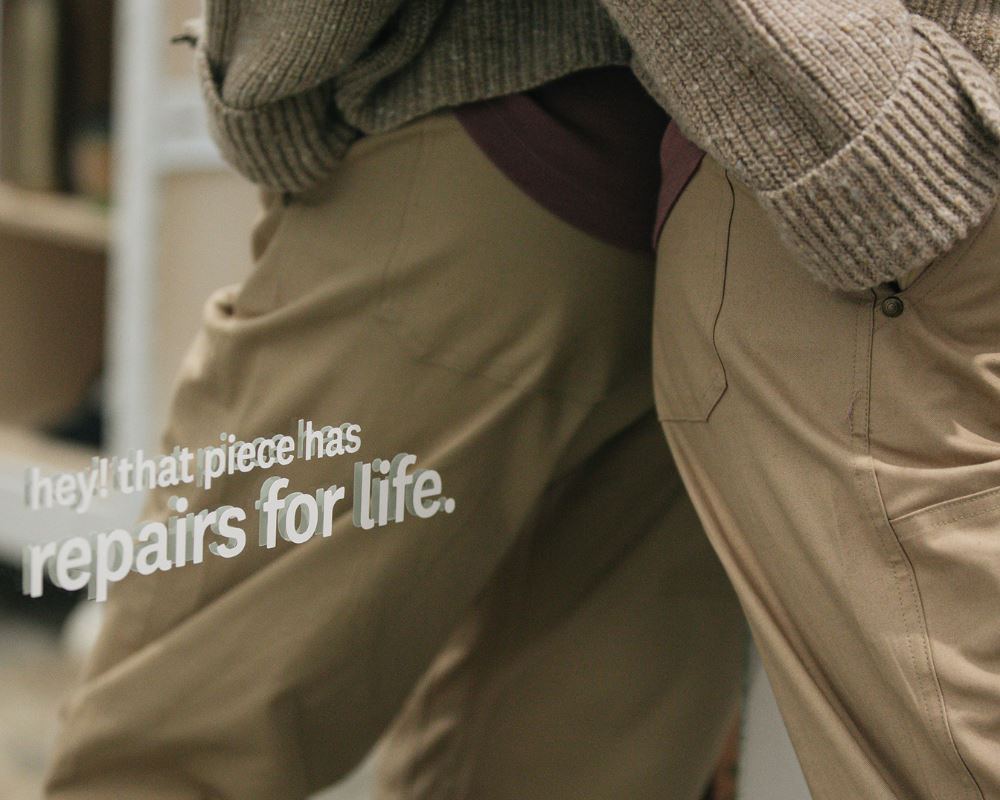There’s something particularly frustrating about snagging your favorite knit sweater by accident, or wearing a hole into the knee of your pants. But for us, the weathering down of products from consistent wear tells a story in itself: that of a life well lived.
If you’ve been around for a while, you know we firmly believe in keeping items in circulation for as long as possible. Three in five new garments produced are thrown away within a year, and we want to work toward changing this. Unlike fast fashion companies, we commit to longevity and take responsibility for the clothing we make.
So, when you do finally wear a hole into your favorite ecologyst pants from kneeling in the garden all summer, we’re here to make sure those pants continue to see life in them with our lifetime repairs program. By repairing a garment and extending the lifespan by just nine months, we can reduce our impact by an average of 20–30% by not replacing it too soon.
Our Repairs for Life program directly speaks to our effort to shift the perception of clothing as disposable.
By repairing a piece rather than replacing it with something brand new, we’re continuing to hold its value and honor the natural resources, materials, and effort that went into making it. By repairing a piece, the hours you’ve spent and the memories you’ve made wearing that item are retained, too.

Caring for your garments so they last
A primary focus of ours is educating our community on how to achieve optimal product longevity (ensuring our products last as long as possible through proper care and use).
But what is product longevity and why does it matter?
Product longevity refers to a product’s physical lifespan and the ability to retain utility until its natural end of life. For clothing to last longer, it requires proper laundering and storage while in use, repairing when it’s worn or damaged, and passing it onto someone else to love it as new when it no longer suits our needs.
Currently, less than 1% of clothing is repaired or recycled into new garments, so it’s crucial that we start adopting habits that combat this so clothing is kept in circulation longer.
How can you help keep a product in circularity for longer?
Buy fewer, better-made products. Opting for quality items ensures more durable materials were used to construct the piece. This saves valuable, usable items from going to landfill.
Wear more, wash less. Avoiding the dryer both lessens an item’s carbon footprint and helps to retain its quality by not wearing the fibers down as quickly.
Sell items second-hand or host a clothing swap. In order to avoid a 1.5 degree increase in global temperatures by 2030, we need to create an ecosystem in which 1 in 5 garments see additional use and care to extend their life. Our Second Life program is a resale platform that allows people to sell their pre-loved ecologyst and Sitka items, allowing for someone else to love it like new.
Repair items when they start to show signs of wear and tear. For instances where you do play a little too hard in your ecologyst Work Pants, or snag a hole in your 195 merino base layers, we got you. Here’s how our lifetime repairs program works.

The Nitty Gritty
Repairs for Life applies to ecologyst and Sitka apparel that breaks down through standard wear. We offer repairs on clothing purchased after January 1, 2015 with a verifiable record of purchase. If your gear happens to fall outside of this window, we will do our best to find a solution, however there may be a charge in these instances based on the nature of the fix.
To submit an item for repair, send an email to our Customer Experience team at info@ecologyst.com along with a description and photos of the item.
Please keep in mind we’re a small but mighty team! It may take up to 4–6 weeks to process and complete your repair from the date you ship it to us. Our factory team works directly with your clothing, so for health and safety reasons we will only accept laundered and clean clothing for repairs.
Item Exclusions: Camp & Cabin hard goods, surfboards, and next-to-skin garments such as socks, masks, and long johns.
Damage Exclusions: Stains, extreme use, misuse cases, and incorrect care/washing are excluded from our lifetime repairs program. Please read the care labels for directions on how to effectively look after your gear, and get in touch if you have any questions.
Food For Thought
If you’re unsure whether your item qualifies for our lifetime repair program, we recommend asking yourself if your garment has lived a full life. Has it accompanied you on countless afternoons in the garden, kneading the dirt with your hands? Has it been your source of comfort while you rest on the couch after a long day? Has it stood the test of time, and if so, are there habits you can implement to ensure it lasts even longer?
If we’re to truly get to the goal of avoiding a 1.5 degree increase in global temperatures by 2030, we need to make incremental changes today. Working toward solutions where 3 in 5 garments aren't sent to landfill within a year of being made is key. Whether that’s through properly caring for your clothing, buying fewer, better quality items, trading with friends, reselling your pieces on second life, or utilizing repair programs such as ours, the choices we make now will impact the future and generations to come.
![]()


